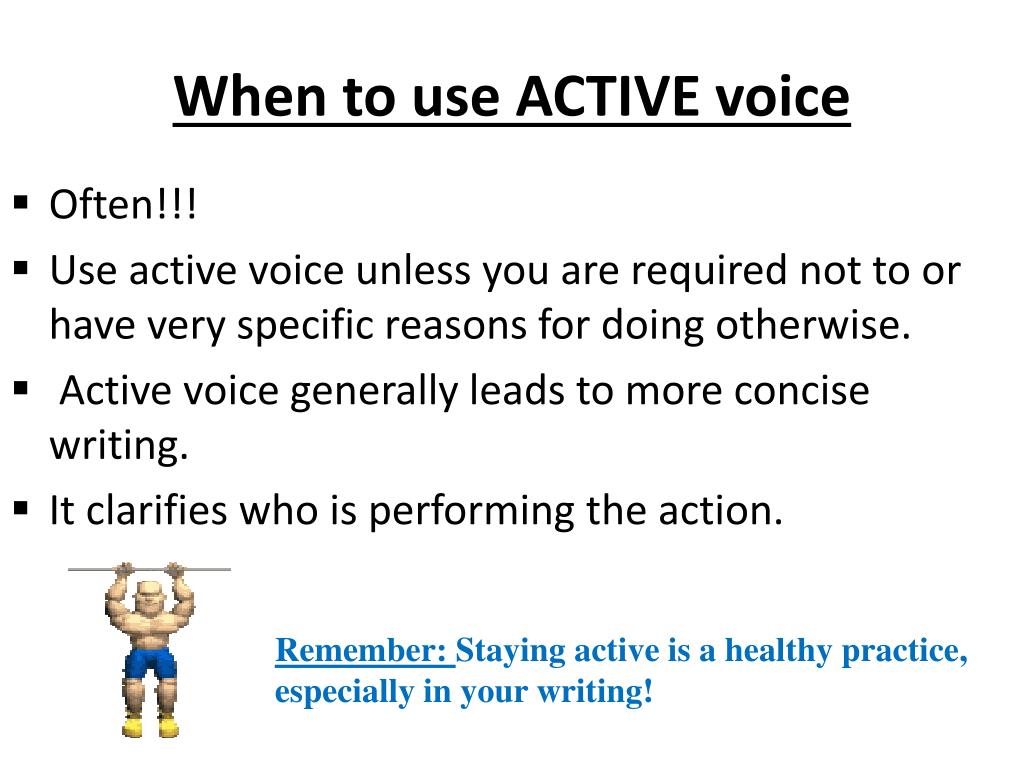
In the passive voice, the subject of the sentence is the recipient of the action. In the active voice, the subject of the sentence is the person or thing doing the verb action. The passive voice emphasises the recipient of the action. The active voice emphasises the person or thing doing the action.

Understanding Active and Passive VoiceĪt its simplest the distinction between active and passive voice is: This page explains the two, and provides some examples to show when you might choose each one in writing and in speech. However, there is a time and a place for the passive voice. Many academic journals also encourage the use of the active voice, generally coupled with the first person (we or I). In school education, children are often taught that they should use the active voice in their writing, because it is ‘stronger’. The passive voice, by contrast, emphasises the recipient or the effect of the action. Using the active voice emphasises the person or thing that is doing the action of the verb. It can take two forms, either active or passive. In this study, we investigated the effects of drug X on the serum levels of phosphorus in post-menopausal women.” Here, using the active voice in the second sentence helps the reader make a clear mental transition from previous studies to the present study.Grammatical voice is a property of verbs in English. For example, consider the following sentences: “Previous studies have established that drug X increases the serum levels of calcium in women with osteoporosis. The active voice is especially useful in the introduction and discussion sections of your manuscript, where you discuss previous research and then introduce your own. So which should you use? The answer is a combination of both.

This is why you would now find the usage “In this study, we investigated…” very common. In fact, multidisciplinary SCI-indexed journals like Nature and specialist journals like the American Journal of Botany, in their instructions for authors, state that the active voice is preferred. However, nowadays, many authorities are going against this traditional notion and encouraging the use of the active voice, with the view that academic papers should be easy to read and understand.

Compare “In this study, we investigated the effect of drug X on the serum levels of phosphorus under various conditions” with “In this study, the effect of drug X on the serum levels of phosphorus was investigated under various conditions.” Until recently, this tone was considered favorable for scientific writing and authors were advised to strictly avoid using the active voice, especially the use of “I” and “we” in their academic research papers. The passive voice lends an impersonal tone, which is perceived to be formal, but can make the text more wordy and difficult to understand, especially when used in long sentences.

On the other hand, in the passive voice, the action being performed is emphasized, and the doer may be omitted, e.g., “The tobacco-infused aerosol was inhaled (by the mice).” In this construction, “by the mice” can be omitted, which means that the reader already knows or does not need to know who the doer is only the action is important. For example, in the sentence “The mice inhaled the tobacco-infused aerosol,” the doer, i.e., “the mice” seem important. The active voice refers to a sentence format that emphasizes the doer of an action.


 0 kommentar(er)
0 kommentar(er)
